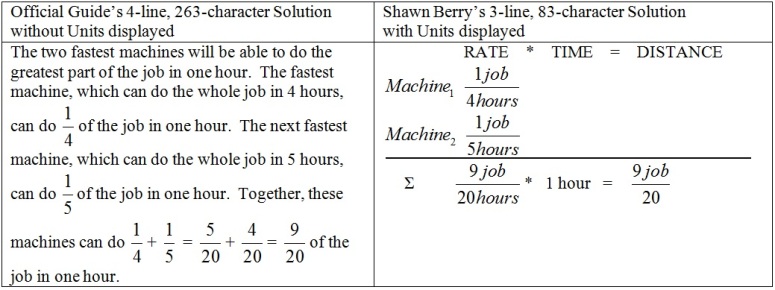2015 OG Quant Review PS #16. Three machines, individually, can do a certain job in 4, 5, and 6 hours, respectively. What is the greatest part of the job that can be done in one hour by two of the machines working together at their respective constant rates?

Math Lessons: (1) Because the machines are working together, add their rates. Then the combined rate (indicated by Sigma, Σ) is multiplied by the applicable number of hour(s); (2) In the Sigma-row, see that hours in the denominator and hours in the numerator cancel. Showing Units is vital to keeping track in R*T=D questions;
(3) Notice that the Official Guide solution is built to work for one hour and is not scalable for a wide variety of hours. My R*T=D solution is scalable to any number of hours and is exactly what you should write when you practice Rate questions and when you take the GMAT-CAT; (4) See that fractional units, here job/hour, indicate a Rate question. Many words indicate fractional units: “per”, “each”, “every”, “for”, “a”, as in $2 per coffee, $2 each coffee, $2 every coffee, $2 for coffee, and $2 a coffee; (4) In due time, you can simply write R * T = D, , , j (for job), and hr., halving your characters and time spent writing; and (5) One-fourth of Problem Solving questions are Rate * Time = Distance. Learning the variations of R*T=D is vital to scoring 700+ on the GMAT.
Character count: The OG writes 263 characters but practically no Math, failing to teach you what to write to solve GMAT questions. Shawn Berry writes 3 lines and 83 characters. The OG solution uses 317% as many characters.
There’s Joy in Repetition: I will always use the same solution, R*T=D, to solve Rate questions. In contrast, the Official Guide for GMAT Review writes an ungodly number of different solution methods for Rate questions.
Shawn Berry (550 level). If two machines complete a job in 4 and 5 hours, respectively, and each machine must complete each job independently, how many hours will the machines take, working together, to complete 3 jobs?
A. 6 2/3
B. 7
C. 7 1/3
D. 7 2/3
E. 8
Shawn Berry (600 level). If two machines complete a job in 4.5 and 5 hours, respectively, how many hours will the machines take, working together, to complete 3 jobs?
A. 7
B. 7 2/19
C. 7 1/9
D. 7 1/5
E. 7 2/9
Shawn Berry (700 level). If two machines complete a job in 4 and 5 hours, respectively, and each machine must complete any quarter of a job independently, how many hours will the machines take, working together, to complete 3 jobs?
A. 6 2/3
B. 7
C. 7 1/3
D. 7 1/2
E. 8
Shawn Berry (800 level). Two machines complete a job uninterrupted in 4 and 5 hours, respectively, but each machine takes two 5 minute breaks each hour so that the human attending can take two 5 minute breaks. In how many hours will the machines take, working together, to complete 3 jobs?
A. 7 1/2
B. 7 2/3
C. 7 3/4
D. 8
E. 8 1/4
Legal Note: “The Graduate Management Admissions Council (GMAC) firmly believes that the Official Guide for GMAT Review is all that you need to perform your best on the GMAT … and that no additional techniques or strategies are needed to do well.” I, Shawn Berry, know better. I have twice earned a perfect 800 on the GMAT-CAT. I document that the Official Guide writes inconsistent, inefficient, and downright confusing solutions that take longer than the allotted 2 minutes/question. Herein I make fair use of GMAC copyrighted material – mostly its confusing solutions – for the transformative educational purpose of teaching students the clear, consistent, and efficient Mathematics, Grammar, and Logic needed to answer GMAT questions in less than 2 minutes.
